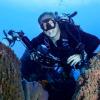Posted 31 August 2011 - 06:24 PM
I came across a write up of Explorer Ventures first trip to the Chincorro Bank. I am sure that it will take a little while for them to get everything running smoothly, and having bouys set up at the top sites and all, but it looks like a very promising destination I think. I am going to probably look into a trip there in April. Is anyone else interested in checking out a new spot. Mayaguana seems like a real popular destination with many divers here. This looks like a similar situation, as is seems like an area that has not been dove much, and is pretty pristine. A spring trip would give EV six months to find the sites, and get things going smoothly. Who else is interested ( hint hint Kamala )? To me, the airfare to Cancun is a lot cheaper than the airfare to so many of the other dive destinations, and the price of the boat is the same as other spots. It should actually make the trip a few hundred dollars cheaper that a lot of their other destinations. Ed
Chinchorro Bank - Moondiver Explorer Trip Report - August 13-20, 2011
.by Explorer Ventures on Wednesday, August 24, 2011 at 11:51am.Capt. Jean-Francois Chabot and President Clay McCardell joined an invited group of dive travel experts and long-time Explorer Ventures clients aboard Capt. Fernando Urquia's M/Y Moondiver Explorer last week for its shakedown cruise to the Chinchorro Bank, off the Yucatan coast near Mexico/Belize border. Aside from a rough, windy and somewhat wet boarding Saturday evening in Mahahual, the weather and diving conditions were as near perfect as we could ask for all week!
As a shakedown cruise, the purpose of the trip was to train crew, identify some of the best dive sites, and learn how the boat handled a full complement of guests and crew and modify the schedule to suit. As expected for this kind of trip, we did experience some mechanical issues during the week that are being addressed (AC condensation not draining properly in the large salon, a couple of pumps that burned out, and a refrigerator that gave up the ghost the day before the trip) - and the crew was on a very steep learning curve on liveaboard diving operations. Things smoothed out over the course of the trip, however, and we were able to generate a long list of items to pay attention to in terms of work needed on board, staffing, tank fill procedures and dive site selection.
We began the trip on the south end of Chinchorro, which is only occasionally visited by divers - and toward the end of the week, worked our way north to areas that rarely, if ever, see any diver traffic. The diving, particulary as we worked our way north, was remote and as close to untouched as you can get in the Caribbean. The dive sites for this trip were all on the western and northern edges of the Chinchorro Bank, which offered excellent protection from the prevailing seas. As a first "regular" trip in an unknown area, we didn't have a 100% success rate in diving the best spots, but we logged many great dives that will be worth multiple dives in the normal itinerary - and the remoteness of the area, coupled with the fact that we didn't see another dive boat all week, was really a highlight of the trip!
Especially in the northern areas, the reefs qualify as some of the most healthy, unspoiled reefs that anyone had seen in the Caribbean. Depths ranged from 110 feet up to less than 15 feet, with the majority of sites on the shallow end of the spectrum, allowing for hour-plus bottom times for many dives. Most of the dives were done in calm conditions with little if any current, and visibility was generally 100 feet+ all week - nearly all dives were done as live boat dives from the Moondiver, though as additional moorings are installed we'll be able to offer more dives as the boat is moored.
What did we see? Myriad sponges, black coral, lizard fish, peacock flounder, basslets, yellowtail snapper, several species of jacks and morays and basslets and wrasses, trumpet fish, barracuda, nurse sharks and several HUGE lobster, red-lipped batfish, filefish, blennies, lizard fish, loads of queen conch, among many other things. Larger pelagics such as the hammerheads and bull sharks seen in June weren't sighted this trip, unfortunately. One of the highlights of the trip were the dives at both Cuarenta Canones (the 18th-century 40 Cannons Wreck), featuring the huge main anchor and an array of brass cannons up to 12+ feet in length, and the drift dive at the Caldera wreck on the northern side of Chinchorro, which led past deeper dropoffs featuring large sponges, myriad marine life, and very large grouper and snapper.
We'll post more pictures as we get them, and are looking forward to having you on board!
Clay McCardell
Explorer Ventures President
.
